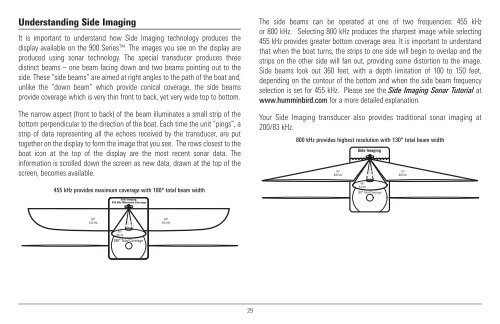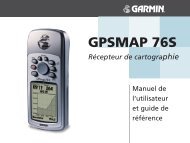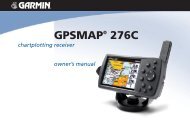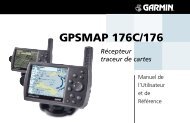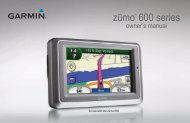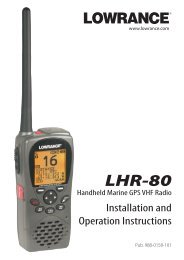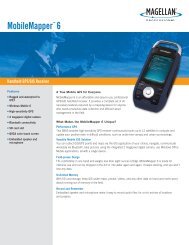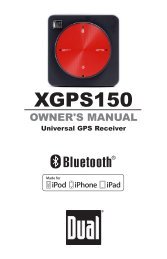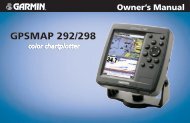Humminbird - Fish Finders and GPS
Humminbird - Fish Finders and GPS
Humminbird - Fish Finders and GPS
Create successful ePaper yourself
Turn your PDF publications into a flip-book with our unique Google optimized e-Paper software.
Underst<strong>and</strong>ing Side Imaging<br />
It is important to underst<strong>and</strong> how Side Imaging technology produces the<br />
display available on the 900 Series. The images you see on the display are<br />
produced using sonar technology. The special transducer produces three<br />
distinct beams – one beam facing down <strong>and</strong> two beams pointing out to the<br />
side. These “side beams” are aimed at right angles to the path of the boat <strong>and</strong>,<br />
unlike the “down beam” which provide conical coverage, the side beams<br />
provide coverage which is very thin front to back, yet very wide top to bottom.<br />
The narrow aspect (front to back) of the beam illuminates a small strip of the<br />
bottom perpendicular to the direction of the boat. Each time the unit “pings”, a<br />
strip of data representing all the echoes received by the transducer, are put<br />
together on the display to form the image that you see. The rows closest to the<br />
boat icon at the top of the display are the most recent sonar data. The<br />
information is scrolled down the screen as new data, drawn at the top of the<br />
screen, becomes available.<br />
455 kHz provides maximum coverage with 180° total beam width<br />
The side beams can be operated at one of two frequencies: 455 kHz<br />
or 800 kHz. Selecting 800 kHz produces the sharpest image while selecting<br />
455 kHz provides greater bottom coverage area. It is important to underst<strong>and</strong><br />
that when the boat turns, the strips to one side will begin to overlap <strong>and</strong> the<br />
strips on the other side will fan out, providing some distortion to the image.<br />
Side beams look out 360 feet, with a depth limitation of 100 to 150 feet,<br />
depending on the contour of the bottom <strong>and</strong> when the side beam frequency<br />
selection is set for 455 kHz. Please see the Side Imaging Sonar Tutorial at<br />
www.humminbird.com for a more detailed explanation.<br />
Your Side Imaging transducer also provides traditional sonar imaging at<br />
200/83 kHz.<br />
800 kHz provides highest resolution with 130° total beam width<br />
55°<br />
800 kHz<br />
Side Imaging<br />
60°<br />
83 kHz<br />
20°<br />
200 kHz<br />
130° Total Coverage<br />
55°<br />
800 kHz<br />
Side Imaging<br />
455 kHz-Maximum Coverage<br />
84°<br />
455 kHz<br />
20°<br />
200 kHz<br />
60°<br />
83 kHz<br />
180° Total Coverage<br />
84°<br />
455 kHz<br />
29


